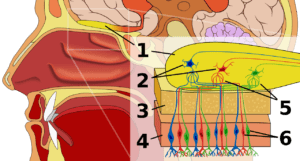Aromatherapy has captured the senses, especially the sense of smell, for centuries. From pampering Egyptian pharaohs to the anointing oil of spices mentioned in the Bible, majestic botanical essences have been highly esteemed and prized throughout history. Aromatic essences have also been an integral part of the healing systems of multiple ancient and modern cultures. So, what is all the fuss? Why have aromatic essences and essential oils stood the test of time? It may be partly related to the most powerful sense human beings possess—the sense of smell.
The sense of smell is vital to human health, allowing humans to identify food, mates, and predators, and detect pleasure and danger (e.g. smoke from a fire or harmful chemicals). Olfaction is the sensory receptors that form the sense of smell. Odor molecules travel to specific sites (olfactory epithelium) and bind to olfactory receptors located in the nasal cavity. Once bound to olfactory cell receptors, intensified signals are transmitted via the olfactory bulb (lying inside the nose and extending to two important areas of the brain: the amygdala and hippocampus) that rapidly reach the limbic area of the brain.
The limbic system is responsible for controlling emotions, memory, learning, instinct, and motivation. In addition, it is involved in sleep, libido, appetite, cardiovascular regulation, breathing, and hormone balance. Through this system, the aroma of essential oils can influence multiple physiological responses to hormones and neurotransmitters in the body.
Here are six fascinating and amazing facts about the sense of smell in humans.
The sense of smell is considered 10,000 times more potent than taste. Other senses like touch, taste, sight, and hearing must travel through the body via neurons in the peripheral nervous system and the spinal cord before reaching the brain (central nervous system). The olfactory response is immediate because of its direct link to the brain. Indeed, this is the only location where the central nervous system is directly exposed to the environment. Direct access to the brain means more rapid and substantial effects.
The sense of smell is the only sense directly connected to the brain. Unlike other senses, that must rely on neuronal communication from the peripheral to the central nervous system to operate efficiently, the sense of smell has a direct link to the central nervous system. Any disruptions in communication from the peripheral nervous system to the central nervous system can diminish these senses. As stated earlier, the olfactory bulb receives odor molecules first and then sends signals to the amygdala and hippocampus, which are strongly linked to emotions and memory. The other senses don’t pass through these areas of the brain, showing us the unique influence odors and smell have on human emotions and memories.
Females use the sense of smell to find a mate. Men and women are attracted to pheromones that the opposite sex produces. Men produce androstenol in fresh sweat (not exposed to oxygen), which is highly attractive to women. Research shows that women who are at the peak of fertility during their menstrual cycle prefer the smell of men with higher testosterone levels. Females also tend to prefer partners with different genes than their own according to scientists. A more diverse set of genes (major histocompatibility complex) produces offspring with a stronger immune system. In essence, women are sniffing out a mate with presumed healthy genes to ensure their offspring are healthy with a more robust immune system. Unfortunately, males don’t appear to have this same “superpower.”
Women have a greater sense of smell. Individuals have differing abilities to identify scents based on various factors. However, women outperform men when it comes to olfactory sensitivity that goes beyond social and cognitive differences between the genders. One study found that women on average have 43% more cells (50% when only neurons are counted) in their olfactory bulb when compared to men. This may account for their greater olfactory sensitivity and also contribute to their above mentioned “superpower” of sniffing out a mate.
Human Olfactory System: 1) Olfactory bulb, 2) Mitral cells, 3) bone, 4) nasal epithelium, 5) glomerulus, 6) olfactory receptor neurons
Olfactory receptors are not isolated to the nasal cavity. Olfactory receptors are chemical sensors responsible for your sense of smell. Scientists once believed that these receptors were isolated to the nasal cavity. That all changed when researchers at John Hopkin’s University School of Medicine (Maryland, USA) published a report reviewing discoveries of olfactory receptors on the kidneys, gastrointestinal tract, muscles, heart, pancreas, liver, lung, and skin. These fascinating findings help us understand that scent receptors play important roles in full human physiology and well-being.
Aromatherapy and scent memories. The sense of smell communicates directly with areas of the brain that store memories and govern emotions. You’ve likely walked into a house or shop and been captivated by a familiar aroma that instantly reminds of a past place, event, or person—think grandma’s perfume or cookies. You may have even felt strong emotions associated with this scent. These experiences are called scent memories and demonstrate how powerful odors are in relation to memories and emotions.
All things considered, the sense of smell is not only fascinating but an absolutely vital part of human well-being. It also shows us how potent aromas, like essential oils, can significantly influence our entire well-being by leveraging this influential sense. Maybe we need a new mantra of smell and be well.

👌👏👏👏👏
Comments are closed.